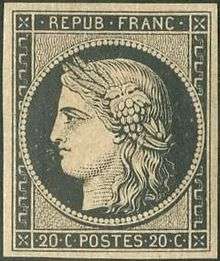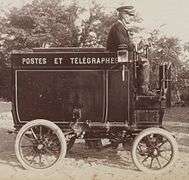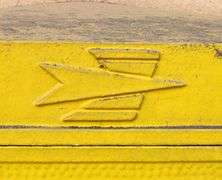La Poste (France)
 | |
| Public limited company | |
| Industry | Postal services, courier |
| Founded | 1991 |
| Headquarters | 44 boulevard de Vaugirard, Paris, France |
Area served | France / Monaco / Andorra |
Key people |
Philippe Wahl (CEO) |
| Services | Letter post, parcel service, banking, insurance, mobile network operator |
| Revenue | €22,163 million (2014)[1] |
| €719 million (2014)[1] | |
| £513 million (2014)[1] | |
| Owner |
French government (73.7%) Caisse des dépôts (26.3%) |
Number of employees | 257,891 (2014) |
| Parent | Groupe La Poste |
| Subsidiaries |
La Poste Geopost La Banque postale La Poste mobile |
| Website |
www |
La Poste is a postal service company in France, operating in Metropolitan France as well as in the five French overseas departments and the overseas collectivity of Saint Pierre and Miquelon. Because of bilateral agreements, La Poste also has the responsibility of mail services in Monaco through La Poste Monaco and in Andorra alongside the Spanish company Correos.
The company was created in 1991 following the split of the French PTT, a government department responsible for mail, telegraph and telephone services in France. The PTT, founded in 1879, were then divided between La Poste, which became responsible for postal service, and France Télécom (nowadays Orange) for the telecommunication services. France Télécom was immediately privatised but La Poste has remained a public company. However, because of EU directives requiring member states to introduce competition in their postal service, the French government allowed private postal service companies in 2005 and transformed La Poste into a public-owned company limited by shares in 2010. Following the examples of Royal Mail in the United Kingdom or Poste italiane in Italy, the French government might sell its shares and float them on the stock exchange in the near future.
La Poste is a parent company of the Groupe La Poste, which also comprises a bank and insurance company (La Banque postale), a logistics service company (Geopost) and a mobile network operator (La Poste Mobile). Although its postal activities are declining because of the development of the Internet, they still represented half of the company's income. Other activities, such as parcel delivery and banking, are on the rise. The two represented respectively a quarter of the company's income in 2014.[1]
History
Kingdom of France
During the Middle Ages, postal delivery in France was not organised by the state and was provided by private enterprise. University envoys dominated the market from the 13th century onwards. In 1477, king Louis XI created coaching inns to deliver his own letters. These inns were for temporary use and usually led to battlefields. In 1576, royal mail delivery was further improved with the creation of the office of royal envoy. Royal envoys were allowed to provide services to private individuals. They prefigured modern postal services and their existence led to the apparition of the first post offices at the end of the 16th century.[2]
The first set fees appeared in 1627 for letters sent to Bordeaux, Lyon, Toulouse and Dijon. As with the rest of Europe, stamps did not exist in France at that time and mail was paid for by the recipient. The first map of post roads was published in 1632 and a book compiling lists of roads and inns including distances and fees to be paid was released in 1707. A new edition was released every two years until 1859. The country already had 623 coaching inns in 1632 and the figure reached 800 at the beginning of the 18th century. A ferme générale was created for mail services in 1672, which meant that postal services started to be subject to taxation. Tax officers progressively bought private postal companies and university envoys became subjects to the ferme générale in 1719. International treaties regarding postal services were signed with neighbouring countries under Louis XIV.[2]
Birth of a national postal service

During the French Revolution, which started in 1789, French postal services progressively became a fully public service. Directors of post offices lost their privileges in 1789 and their position became subject to universal suffrage. The ferme générale was abolished two years later and post offices started to be directly administered by the state. As a reaction to commonplace opening of letters by the royal authorities, an oath of confidentiality became compulsory for post employees in 1790. The first French mail coach appeared in 1793 and the first telegram in the world was delivered in 1794 with the Chappe optical transmitter on the Paris-Lille line.[2]
After the Revolution, French postal services continued their modernisation. A 1801 decree reasserted the state monopoly on mail delivery, postal orders were created in 1817 and postage stamps were introduced in 1849, nine years after they were invented in the United Kingdom. A rural service was implemented in 1830 with a mail delivery in rural areas every two days. The delivery became daily from 1832.[2]
France was a founding member of the General Postal Union in 1874. It became the Universal Postal Union in 1879.[2]
French PTT
Post and telegraphs were united in one administration by the French government in 1879, giving birth to the P&T ("Postes et télégraphes") which later became the PTT ("Postes, télégraphes et téléphones"). A French ministry of post and telegraphs was created the same year. A national savings bank opened in 1881 and was added to the services provided by the P&T. The government took the monopoly on telephone in 1889 and placed the service under the P&T.[2] The administration then became PTT and kept this name until 1959 when it became "Postes et Télécommunications", although the acronym PTT was kept.
Postal cheques were created in 1918. The first airmail flight operated in 1912 between Nancy and Lunéville and a regular airmail network was put in place in 1935 through the "Air Bleu" company. Night airmail services started in 1939 on two lines: Paris-Bordeaux-Pau and Paris-Lyon-Marseille. Postcodes were introduced in France in 1964.[2]
 Logo of the French PTT on a former post office in Lille.
Logo of the French PTT on a former post office in Lille. A PTT sign in Auxerre.
A PTT sign in Auxerre.- A 1950s PTT road sign in Marthon.
 A 1922 stamp.
A 1922 stamp. A mail van in 1901.
A mail van in 1901. A Citroën 2CV vehicle used by PTT.
A Citroën 2CV vehicle used by PTT. A Citroën H Van used by the PTT.
A Citroën H Van used by the PTT.
La Poste
%2C_la_poste.jpg)
In the 1980s, it became clear that the French PTT could not compete anymore in a country where communication was greatly increasing. The administration suffered from a constant lack of innovation and was dependent on political will and decisions. A division between postal and telecommunication services was suggested as soon as 1974 in a report from the Parliament. However, changes in the structure of the PTT were opposed by trade unions who feared that employees could lose their status of civil servants.
In 1988, under the premiership of Socialist Michel Rocard, a law was finally prepared to split the PTT. The aim of the government was to get the services out of the public administration and to prepare competition from private firms. Such as move in encouraged by the European Economic Community and the United Kingdom had already separated its national telephone company from its postal services in 1981. Most of the other member states did the same in the late 1980s and early 1990s.
Trade unions organised several strikes but the law was adopted in 1990. La Poste and France Télécom were officially created on 1 January 1991. The two had the status of "autonomous operators under public law". While France Telecom was privatised and floated on the stock exchange in 1997, La Post has remained a public service.
Since its creation, the company has had to face severe competitiveness from the Internet. As a result, it has tried to innovate and diversify its activities. In 2000, it became a webmail provider and created GeoPost, its logistics and parcel delivery subsidiary. The following year, it released its online trading platform to reinforce its online banking services. To comply with the law and EU directives, the banking activities had to form a distinct subsidiary in 2006, called La Banque postale. It received the official status of a bank while it had remained a public savings bank until then.[2]

La Poste lost its monopoly on postal delivery in 2005. Since then, several competing firms have started business in France. Most of them only deliver parcels (TNT Express, DHL Express, United Parcel Service...) or recorded letters, while mail delivery itself has yet to attract private companies. Most of the companies dealing with mail services only operate on a local scale, because they cannot compete with the extremely wide network of offices La Poste enjoys throughout the country.[3]
La Poste became a public limited company in 2010. Although most of the Western European countries have fully privatised their postal service companies, public opinion in France is largely against such a move. A majority of French citizens fear that if La Poste becomes a private company, many post offices would close, rural areas would be neglected and stamps would be more expensive. Supporters of privatisation claim that it would help solving the debt (€5.8 billions in 2009) and contain the rise of prices.[4]
In 2013 La Poste invested around €1 billion in renovating post offices, modernizing infrastructure and reinforcing its network, along with the purchase of electric delivery vehicles. Acquisitions included more Seur franchises in Spain, a 40% stake in Indian parcel firm DTDC and a similar stake in French parcel firm Colizen. The company also bought a 66% stake in freight forwarder Tigers. Via its joint venture with Swiss Post, Asendia, the Group acquired Pitney Bowes’ international mail business operations in the UK, and a 40% stake in Irish e-commerce firm eShopWorld.[5]
Activities
Mail delivery


La Poste is by far the largest provider for mail delivery in France. It treated 15 billions messages in 2012, of which 97% implied an administration or a firm. Relations to customer only represented 55% of the company's revenue (55% for business relations ; 16% for advertisement). International mail delivery accounted for 7% of the 2012 revenue. The same year, Swiss Post and La Poste launched a joint company, Asendia, to merge their international mail activities.[6]
La Poste offers three different rates for sending mail in France: first-class, second-class and green letter. The latter was introduced in 2011 to provide an ecological alternative to the regular rates. It emits 15% less CO2 than first-class letters. In 2012, it accounted for one in five priority letters.[7]
Parcels and Express (GeoPost)
GeoPost groups most parcel subsidiaries of La Poste Group. In France, the company provides two brands, Chronopost and DPD (formerly Exapaq). Worldwide, the brands are DPD,[8] Yurtiçi Kargo and Seur GeoPost.
La Poste is the second biggest provider for parcel delivery in Europe, with a 15% share of the market and a €5 billion revenue.[9]
Other activities
In addition to postal services, La Poste also offers banking and insurance services (with La Banque Postale) and, via Chronopost, courier services. After the government, La Poste is the second largest employer in France. It also offers webmail, providing @laposte.net email addresses and hosts approximately 1.6 million active email accounts.[10] More recently, the group has created a branch for communication councelling (Mediaprism), document exchange and archiving (Docapost), real estate (Poste Immo) and mobile telephony (La Poste Mobile, in partnership with SFR).
Corporate identity
Yellow is the main colour of the French post since the 1960s. Previously, postal vans used to be green and post boxes blue. Yellow was chosen because it is a colour that is easily seen and because it can symbolise speed and light. The logotype of La Poste was created by poster designer Guy Georget. It represents a bird, often called the "postal bird" ("l'oiseau postal"), symbolising a messenger. Its design was slightly altered by Georget in 1978.[11]
 The 1960 bird.
The 1960 bird. Current design.
Current design.
References
- 1 2 3 4 "Chiffres clés". Groupe La Poste. Retrieved 28 November 2015.
- 1 2 3 4 5 6 7 8 "Instantané : Les grandes dates clés". La Poste.
- ↑ Céline Tridon (1 July 2011). "Courrier: peut-on se passer de La Poste?". Chef d'Entreprise.
- ↑ Georges Sarre (15 October 2008). "Contre la privatisation de la Poste". Libération.
- ↑ La Poste Group profits hit by declining mail volumes
- ↑ "Le courrier, support des échanges économiques et commerciaux". Groupe La Poste.
- ↑ "Le lien renouvelé du courrier". La Poste.
- ↑ “GeoPost and La Poste Group,” GeoPost (Global express parcel). Retrieved 25-04-2013.
- ↑ "Deuxième opérateur de colis-express en Europe".
- ↑ "Troubles with webmail migration" (in French). www.arobase.org. 2007-07-27.
- ↑ Chronique du timbre-poste français, 2005, page 180.
External links
| Wikimedia Commons has media related to La Poste (France). |
- La Poste website (French)
- Postal Services in France - at Discover France (English)
- French Post Boxes through the ages. (English)